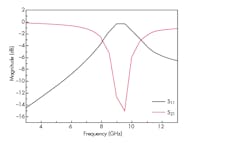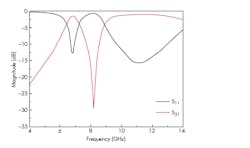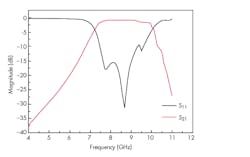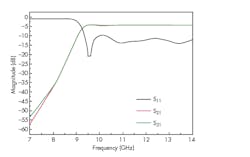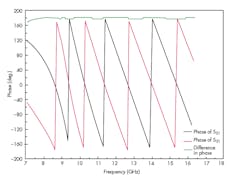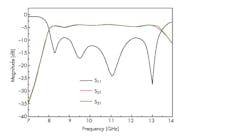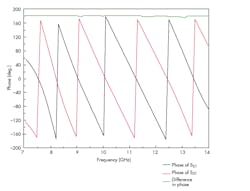Download this article in PDF format.
Bandpass filters are among the most useful building-block high-frequency components in modern communications networks, for functions such as providing signal isolation and spectral cleaning. Waveguide bandpass filters provide outstanding electrical performance, but are relatively large in size. However, substrate-integrated-waveguide (SIW) transmission-line technology delivers good performance from compact planar formats such as printed circuit boards (PCBs), and can be readily integrated with other transmission-line formats, e.g. microstrip, as needed for high-frequency component and subsystem design.1
In fact, SIW components can be thought of as traditional rectangular waveguide in planar form. This allows a transition of most classical waveguide components into more compact SIW forms. There are inevitable tradeoffs between the two formats, with conventional waveguide lower in loss but larger in physical size. However, the very good electrical performance of SIW components combines well with the compact, planar formats that can be made to fit many system designs.
SIW technology is the catalyst behind a wide range of passive high-frequency components, including planar SIE phase shifters,2 power dividers,3 circulators,4 directional couplers,5 six-port circuits,6 and low-cost filters.7 A variety of resonator-based filters have been developed with SIW approaches, too, including post, iris, and cavity-type filters.
Overall, the low insertion loss, sharp rejection cutoff, and low cost of these filters has made them invaluable for modern wireless communications systems. To explore the design of SIW bandpass filters, some examples will be shown using circular complementary split-ring resonators (CSRRs) fabricated on readily available commercial PCB material and with design guidance using the High Frequency Structure Simulator (HFSS) electromagnetic (EM) simulation software from ANSYS.
CSSRs have been proposed for the synthesis of negative-permittivity and left-handed (LH) metamaterials in planar circuit configurations.8 They can serve as useful circuit design elements: CSRRs etched in the ground plane or conductor of a planar transmission-line format, such as microstrip or coplanar waveguide (CPW), provides a negative effective permittivity with resulting stopband behavior in the vicinity of the frequency of the resonant structures. CSSRs have been applied to the design of compact bandpass filters (BPFs) to achieve low bandpass loss with high out-of-band rejection.7
A balun, which is a balanced/unbalanced network, enables an unbalanced input signal to be transformed to a pair of balanced output signals 180 deg. out of phase, as might be used in balanced frequency mixers.9 It is possible to combine the highpass characteristics of SIW transmission lines and the bandstop characteristics of CSSRs to form an SIW balun/BPF in compact, planar format with good electrical performance.10,11
1. This graphical depiction of a rectangular SIW circuit structure shows how it is formed with two rows of drilled, metallized viaholes along the dielectric material.
The graphic representation of a rectangular SIW section (Fig. 1) is based on a circuit structure fabricated on commercial DiClad dielectric substrate material from Arlon, now part of Rogers Corp. The substrate material has a relative permittivity or dielectric constant (εr) of 3.38, dissipation factor (tanδ) of 0.0009, and height (h) of 0.81 mm.1-3
The SIW circuit structure is formed by drilling and metalizing two rows of holes through the circuit-board material to establish contact between the two metal planes of the dielectric substrate material. Parameter Weq represents the width of the corresponding rectangular waveguide circuit or component that is replaced by the rectangular SIW (RSIW) circuit structure.3 Parameters for the SIW circuit include the width of the RSIW (WSIW), the diameter of the via holes (d), and the space between the viaholes (p).2
2. These electric-field distributions represent the TE10 mode at 12 GHz for an equivalent rectangular waveguide structure (left) and an RSIW structure (right).
Based on previous work,2 empirical equations were derived for determining the width of the equivalent rectangular waveguide, using the same fundamental-mode propagation characteristics as the RSIW of Figure 2. The same height and dielectric material parameters were used for the RSIW filter, and parameter analysis was performed by using the finite-element method (FEM) included as part of the HFSS EM simulation software:12
Weq = WSIW{ξ1 + ξ2/[(p/d) + (ξ1 + ξ2 - ξ3)/( ξ3 -ξ1)]} (1)
with
ξ1 = 1.0198 + 0.3465/(WSIW/p − 1.0684)
ξ2 = –0.-183 – 1.2729/(WSIW/p − 1.2010)
ξ3 = 1.0082 – 0.9163/(WSIW/p + 0.2052)
and
p ≤ 2d
Designing an SIW BPF
Complementary split-ring resonators (CSRRs) are sub-wavelength planar structures that have been produced as metamaterial resonators,8 and can be thought of as electric dipoles. According to the theory of evanescent-mode propagation for a waveguide loaded by electric dipoles, a bandpass below the waveguide cutoff frequency can be obtained by properly loading the CSRRs.
SIW technology is suitable for loading CSRRs on a waveguide surface, so that SIW-loaded complementary resonators such as CSRRs are effective structures for achieving compact BPFs. The technique yields miniature waveguide filters, in contrast to much larger, conventional waveguide filters based on bulk resonators.
3. A bandpass filter can be realized in a simple CSRR printed-circuit configuration such as this, using circular slotted split rings.
To offer some insight into the compact size and high-performance possibilities in designing an RF/microwave BPF with integral balun using SIW transmission-line technology with SSRRs, a filter was designed on a CPW circuit configuration. The filter design is relatively simple (Fig. 3), consisting of two CSRRs printed on circuit material with thickness (h) of 0.81 mm and dielectric constant (εr) of 3.38.
4. This HFSS simulation shows the modeled response of the CSRR circular ring filter structure for 3 to 13 GHz.
ANSYS’s HFSS EM simulation software was used to simulate the RF/microwave performance of the SIW BPF design with integrated balun from 3 to 13 GHz. Figure 4 shows the response for the full-wave simulation, with levels about as expected at 9.48 GHz; the design features negligible return loss of 14.86 dB and quite low insertion loss of 0.31 dB. The SIW BPF consists of input and output coupling lines with CSRR-loaded SIW.3,4An SIW filter with bandpass response7 was achieved by combining the highpass characteristics of the SIW and the bandstop characteristics of the CSSRs.8
5. This SIW planar transmission line includes a circular single-ring CSRR structure.
Figure 5 shows the design of the filter based on a single CSRR cell. Simulations were performed on the dielectric substrate material used for the filter and other circuit structures, since various SIW-planar structure transitions were needed to integrate the filter, balun, and other circuit functions within the same circuit material.
6. These simulated plots show the forward transmission (S21) and reflection coefficient (S11) for the SIW with single-ring CSRR and tapered transitions (of Fig. 5).
The design of the SIW-to-microstrip transition is straightforward,13 making use of a tapered microstrip line to excite the waveguide mode (Fig. 5, again). The transition offers excellent performance over a broad bandwidth capable of covering the full SIW operating bandwidth. As the HFSS simulations show, the filter achieves a bandpass of 7.71 to 8.58 GHz, with excellent return loss of 29.15 dB and low bandpass insertion loss of only 0.74 dB, both at 8.20 GHz (Fig. 6).
7. An SIW bandpass filter was designed using three circular ring CSRR cells.
After creating the design for this single cell, multiple cells were cascaded together to form a complete BPF for use with the SIW filter/balun structure. The full bandpass characteristics of the design are achieved by cascading the cells (Fig. 7). This larger SIW BPF structure with cascaded CSRRs shows promising simulated performance for both return loss and bandpass insertion loss, with simulated return loss of 30.41 dB at 8.66 GHz and simulated insertion loss of 1.04 dB at the same bandpass frequency. The filter portion of the integrated design offers respectable return loss and insertion loss across a fairly wide bandpass, from 7.59 to 9.89 GHz (Fig. 8).
8. These simulations plot the forward transmission (S21) and reflection coefficient (S11) for the SIW BPF based on the three CSRR cells.
SIW Balun BPF
A balun is a circuit that converts signals from an unbalanced state to a balanced state, as might be needed within different systems. An unbalanced-to-balanced line transformer was first proposed by Marchand in 1944.9 Because of its output-balanced characteristics and output phase difference of 180°, it is useful for many applications.
Many microwave circuits, for example, require balanced inputs and outputs to reduce noise, minimize higher-order harmonics, and improve dynamic range. Baluns are often used as “building-block” components to realize designed performance functions in wireless communications systems, working together with balanced frequency mixers, push-pull amplifiers, and antenna feed networks.10,11
9. The other ingredient in the SIW balun/BPF, the unbalanced/balanced transformer, is shown here in SIW transmission-line technology.
Passive baluns can be constructed with coplanar waveguide (CPW) transmission lines, coaxial lines, or microstrip transmission lines. As an alternative approach, a broadband passive balun transformer was designed using SIW transmission-line technology (Fig. 9). This SIW balun design consists of a −3-dB SIW power divider, which provides a split of a single input port to two, evenly divided output power levels, and microstrip lines that are placed on different sides of a dielectric substrate at balanced ports to obtain a 180-deg. phase shift.3,5 Since the SIW power divider features broadband characteristics, the resulting balun structure also provides broadband frequency response that’s useful for many wireless communications applications.
This use of a power divider and microstrip lines with specific electrical lengths makes it possible to realize a broadband, high-frequency balun in SIW circuit technology.9,10 As had been shown earlier, the SIW transmission-line technology is also useful for designing and fabricating a compact BPF. By combining the circuit structures with a common SIW circuit technology, the equivalent of a multiple-function component with filtering and line-matching capabilities can be designed using a common SIW circuit architecture.
10. The simulated performance for three scattering parameters for the SIW balun are shown here, using HFSS simulation software.
11. The differences in phase for the outputs of the SIW balun were simulated with HFSS software.
Simulations of the multiple-function circuit design were performed with commercial ANSYS HFSS EM simulation software12 to predict the amplitude response and the phase balance of the SIW planar balun, with simulated levels of scattering parameters S21 and S31 close to −3.76 dB with return loss (S11) of −20.51 dB at 9.56 GHz and with the phase responses of parameters S21 and S31 having a 180-deg. difference between them (Figs. 10 and 11).
12. The combination of the bandpass filter and the balun is modeled using SIW transmission-line technology.
Using SIW CSRRs, a combination of the balun and the bandpass filter was designed for fabrication on a common circuit board.14 Critical to the performance of the balun/filter circuit structure is the performance of the SIW power divider (presented earlier), and the cascade of 10 CSRRs that are etched on the PCB’s top metal plane (Fig. 12).8 Tight control of these structures during the design and fabrication stages of this circuit help to maintain required frequency tolerances for the filtering bands with proper suppression of undesired spurious or harmonic signal content in order to achieve the widest-possible operating bandwidth for the balun/filter combination component.9
13. The simulated performance for three scattering parameters for the SIW balun/BPF combination are shown here, using HFSS simulation software.
With the help of the HFSS software, 180-deg. reverse phase characteristics between the two output ports can be easily modeled and realized with a multilayer SIW power divider. The multilayer power divider’s performance parameters are finely tuned to achieve good wideband performance. The simulation results shown in Figure 13 indicate that the power levels of scattering parameters S21 and S31 are close to −3.78 dB in the frequency range from 8.26 to 13.04 GHz with return loss (S11) of greater than −10 dB across the frequency range of 9.02 to 11.94 GHz or for 27.86% of the bandwidth. Figure 14 shows the phase response of parameters S21 and S31 with a full 180-deg. difference in phase.
14. The differences in phase for the outputs of the SIW balun/BPF combination were simulated with HFSS software.
The balun BPF was designed in the form of a compact SIW power divider with good simulated results. It was realized with two balanced output ports on both sides of the circuit substrate to achieve a 180-deg. phase difference between the output ports. For good high-frequency selectivity, 10 CSRRs were etched on the top metal plane of the circuit substrate. As the EM simulations show, it is possible to achieve good balanced electrical performance and high selectivity with this SIW configuration. In fact, performance approaches that of a traditional waveguide component structure, but in a much more compact SIW component.
References:
1. D. Deslandes and K. Wu, “Design Consideration andPerformance Analysis of Substrate Integrated Waveguide Components,” European Microwave Conference, October 2002, pp. 1-4.
2. Y. Cassivi, L. Perregrini, P. Arcioni, M. Bressan, K.Wu, and G. Conciauro, “Dispersion Characteristics of Substrate Integrated Rectangular Waveguide,” IEEE Microwave Wireless Components Letters, Vol. 12, No. 9, 2002, pp. 333-335.
3. Rahali Bouchra, “Contribution à la Modélisation Electromagnétique des structures Complexes
Hyperfréquencesen Technologie SIW,” Thèse dedoctorat, Département de Génie Electriqueet
Electronique, Faculté de Technologie, Université AbouBekrBelkaid de Tlemcen Algérie, May 2013.
4. Nathan Alexander Smith, “Substrate Integrated Waveguide Circuits and Systems,” thesis for the degree
of Master of Engineering, Department of Electrical & Computer Engineering, McGill University, Montréal,
Québec, Canada, May 2010.
5. Bouchra Rahali and Mohammed Feham, “Design of K-Band Substrate Integrated Waveguide Coupler,
Circulator, and Power Divider,” International Journal of Information and Electronics Engineering, Vol. 4, No. 1, January 2014, pp. 47-53.
6. Ke Wu, Dominic Deslandes, and Yves Cassivi, “The Substrate Integrated Circuits - A New Concept for
High-Frequency Electronics and Optoelectronics,” Microwave Review, December 2003.
7. Bouchra Rahali,Mohammed Feham, Achour Ouslimani, Abed-Elhak Kasberi, and Junwu Tao, “Fabricate C-Band Components with Rectangular SIW,” Microwaves & RF, April 2016.
8. J. Bonache, F. Martin, R. M. Sillero, F. Falcone, T. Lopetegi, M. A. G. Laso, J. Garcia-Garcia, I. Gil, M. F. Portillo, and M. Sorolla, “Equivalent-Circuit Models forSplit-Ring Resonators and Complementary Split-RingResonators Coupled to Planar Transmission Lines,” IEEE Transactions on Microwave Theory & Techniques, Vol. 53, No. 4, April 2005.
9. N. Marchand, “Transmission-Line Conversion Transformers,” Electronics, Vol. 17, No. 12, December 1944, pp. 142–145.
10. Z. Y. Zhang, Y. X. Guo, L. C. Ong, and M. Y. W. Chia, “Improved Planar Marchand Balun with a Patterned Ground Plane,” International Journal on RF/Microwave CAE, Vol. 15, No. 3, May 2005, pp. 307–316.
11. R. Sturdivant, “Balun Designs for Wireless Mixers, Amplifiers and Antennas,” Applied Microwaves, 1993, pp. 34–44.
12. User’s guide – High Frequency Structure Simulator (HFSS), v11.0, Ansoft Corp.
13. Dominic Deslandes, “Design Equations for Tapered Microstrip-to-Substrate Integrated Waveguide
Transitions,” 2010 IEEE International Microwave Theory & Techniques Symposium (MTT-S), Symposium Digest, pp. 704-707.
14. Z. C. Hao, W. Hong, J. X. Chen, X. P. Chen, and K. Wu,“Planar Diplexer for Microwave Integrated Circuits,” IEE Proceedings on Microwave Antennas & Propagation, Vol. 152, No. 6, December 2005.




